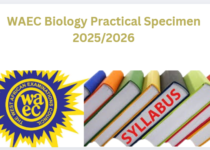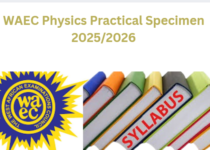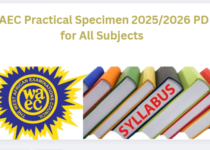WAEC Fisheries Practical Specimen 2025/2026
WAEC Fisheries Practical Specimen 2025/2026 Here, We will be providing you the accurate WAEC Fisheries Practical Specimen 2025/2026, WAEC Fisheries Practical Specimen 2025 pdf, WAEC Fisheries Practical Specimen 2025/2026, WAEC Animal Husbandry Practical Specimen 2025/2026, WAEC Fisheries Practical Answers 2025/2026, WAEC Fisheries Practical Answers 2025Pdf, and WAEC Fisheries Practical Answers 2025/2026.
| Specimen | Description |
|---|---|
| Specimen A | Fresh African Catfish |
| Specimen B | Fresh Tilapia with Scales |
| Specimen C | Drag Net |
| Specimen D | Fish Trap |
| Specimen E | Hook and Line |
| Specimen F | Cast Net |
| Specimen G | Smoked Fish |
| Specimen H | Knife |
| Specimen J | Charcoal |
| Specimen K | Wire Mesh or Gauze |
| Specimen L | Twine |
| Specimen M | Float |
| Specimen N | Lead or Weight |
| Specimen Q | Canoe (Model) |
WAEC Fisheries Practical Specimen 2025/2026
Contents
- 1 WAEC Fisheries Practical Specimen 2025/2026
- 2 Specimen A – African Catfish (Fresh)
- 3 Specimen B – Tilapia (Fresh with Scale)
- 4 Specimen C – Drag Net
- 5 Specimen D – Fish Trap
- 6 Specimen E – Hook and Line
- 7 Specimen F – Cast Net
- 8 Specimen G – Smoked Fish
- 9 Specimen H – Knife
- 10 Specimen J – Charcoal
- 11 Specimen K – Wire Mesh/Gauze
- 12 Specimen L – Twine
- 13 Specimen M – A Float
- 14 Specimen N – Lead/Weight
- 15 Specimen Q – Canoe (Model)
- 16 How To Pass WAEC Fishery 2025/2026 Examination
- 17 Determination
- 18 Self Believe
- 19 Early Preparations
- 20 Read WAEC-Recommended Textbooks
- 21 Be aware of common mistakes students make during the WAEC examination and take steps to avoid them.
- 22 Attend WAEC Tutorials
- 23 Recent Posts
WAEC Fisheries Practical Specimen 2025/2026
Specimen A – African Catfish (Fresh)
This specimen represents the African catfish, a common freshwater species in fisheries. African catfish are distinguishable by their sleek, scaleless bodies and prominent barbels or whiskers near their mouths. Understanding their biology, habitat, and basic handling techniques is essential for success in the examination.
Specimen B – Tilapia (Fresh with Scale)
Tilapia is another significant freshwater fish species, and this specimen showcases a fresh tilapia with its scales intact. The scales of tilapia provide insights into their age and health. These fish are prized for their mild flavor and adaptability to aquaculture. Candidates may be evaluated on their ability to identify and handle tilapia correctly.
Specimen C – Drag Net
A drag net is a fundamental fishing tool used for capturing fish in larger quantities. It comprises a wide, rectangular net with floats on the top and weights on the bottom, allowing it to be dragged through the water to encircle and trap fish. Candidates need to understand how to deploy and retrieve a drag net, as it is a common method used in both commercial and artisanal fishing.
Specimen D – Fish Trap
Fish traps are ingenious devices designed to lure and capture fish. This specimen represents a typical fish trap, highlighting its structure and design. Candidates may be expected to explain how fish traps work, the different types available, and their ecological impact.
Specimen E – Hook and Line
The hook and line method is a traditional fishing technique that involves using hooks attached to lines to catch fish. This method is selective, allowing fishermen to target specific species or sizes. Candidates should have knowledge of various hooks, baiting techniques, and the safe handling of hook and line equipment.
Specimen F – Cast Net
The cast net is a circular fishing net that is cast out and then drawn back in, trapping fish within its radius. Casting a net effectively requires skill and precision. Candidates may be asked to demonstrate the correct technique for casting a net and explain its advantages in certain fishing scenarios.
Specimen G – Smoked Fish
Smoked fish is a preserved product commonly found in fisheries. This specimen represents fish that have undergone smoking, a preservation method that utilizes heat and smoke from burning charcoal or wood. Candidates may be questioned about the smoking process, its benefits, and its role in extending the shelf life of fish.
Specimen H – Knife
The knife is a versatile tool in fisheries, used for cleaning, gutting, and filleting fish. Candidates should understand the importance of knife safety, proper handling, and its various uses in fish processing.
Specimen J – Charcoal
Charcoal is often used in smoking fish as a source of heat and smoke. Candidates need to explain the role of charcoal in smoking, its properties, and how it contributes to preserving fish.
Specimen K – Wire Mesh/Gauze
Wire mesh or gauze is a common material used in constructing various fishing equipment such as traps and screens. Candidates should be familiar with its properties, durability, and applications in fisheries.
Specimen L – Twine
Twine is strong and durable string or cordage used in various fishing activities, including net repair and construction. Candidates should understand its characteristics, types, and its significance in fisheries.
Specimen M – A Float
Floats are buoyant objects used to keep fishing lines or nets afloat in the water, ensuring that they remain at the desired depth. Candidates should be able to explain the purpose of floats and how they assist in fishing operations.
Specimen N – Lead/Weight
Lead or weights are added to fishing lines or nets to help them sink or maintain a specific depth in the water. Candidates should understand the importance of weights in fishing and their role in different fishing techniques.
Specimen Q – Canoe (Model)
This specimen represents a model of a canoe, which is a common watercraft used in fishing. Candidates may be asked to describe the various parts of a canoe, its stability, and its suitability for different fishing environments. Understanding the role of canoes in fisheries is essential for candidates aiming to excel in the examination.
How To Pass WAEC Fishery 2025/2026 Examination
Determination
Success requires determination, and it’s crucial to believe in yourself and commit to passing the WAEC exam in one sitting. While many find it challenging, your mindset and hard work play a significant role in your success. Don’t be discouraged by others, if you stay determined, work hard, and remain steadfast, you can achieve your goal just like those who have succeeded before you.
Self Believe
Believing in yourself goes beyond positive affirmations; it involves setting realistic goals and taking actionable steps to achieve them. Start by establishing long-term goals like passing the exam, assessing what you need in terms of finances, materials, and study time, and ensuring you’re in the right mental state.
For short-term goals, break down your plan: determine daily study hours, decide how to acquire necessary materials, and create a balanced schedule that includes rest. By aligning your short-term actions with your long-term objectives, you’ll be better equipped to envision and achieve success.
Early Preparations
There have been debates on the ideal time for WAEC candidates to start preparing for the exam. Some suggest starting 6 months before, others recommend 3 months, and some believe preparation should begin from the first day in secondary school.
All these perspectives have merit. However, the best time to start preparing is now. Even if you’re just starting a few weeks before the exam, you can still achieve excellent results by beginning your studies immediately. It’s never too late—start covering as many topics as possible and remain dedicated. With determination and effort, success is still within reach.
All these perspectives have merit. However, the best time to start preparing is now. Even if you’re just starting a few weeks before the exam, you can still achieve excellent results by beginning your studies immediately. It’s never too late start covering as many topics as possible and remain dedicated. With determination and effort, success is still within reach
Read WAEC-Recommended Textbooks
To succeed in the 2025/2026 WAEC examination, acquiring the recommended WAEC materials, including textbooks, notebooks, and past questions is crucial. These resources are essential for mastering all subjects.
Past questions are especially important, as they help you understand the structure of WAEC exams and often include repeated questions. However, relying solely on past questions isn’t enough; your textbooks, notebooks, and key points are equally important for achieving good grades
Be aware of common mistakes students make during the WAEC examination and take steps to avoid them.
Candidates often fail the WAEC examination due to simple mistakes. WAEC not only tests your knowledge but also your ability to follow instructions. Even well-written answers can lose marks due to small errors. Common mistakes include:
- Not writing names in capital letters.
- Entering the wrong center or seat number.
- Writing across margin lines.
- Answering questions with responses meant for others.
To avoid these mistakes, structure your answers before writing them down. This not only helps prevent errors but also makes your work more presentable, potentially earning you extra marks.
Attend WAEC Tutorials
Attending WAEC tutorials can significantly boost your chances of success for several reasons. These tutorials are often led by experienced educators familiar with the WAEC curriculum and exam format. They offer valuable tips, strategies, and targeted lessons on key topics, ensuring comprehensive preparation.
Tutorials also provide personalized attention, allowing you to address specific questions and challenges. The interactive nature of tutorials promotes engagement, discussion, and collaborative learning with peers, which can enhance your understanding of complex concepts. Consistent participation in these sessions helps maintain focus and discipline, keeping you on track with your study plan.
tes engagement, discussion, and collaborative learning with peers, which can enhance your understanding of complex concepts. Consistent participation in these sessions helps maintain focus and discipline, keeping you on track with your study plan.


